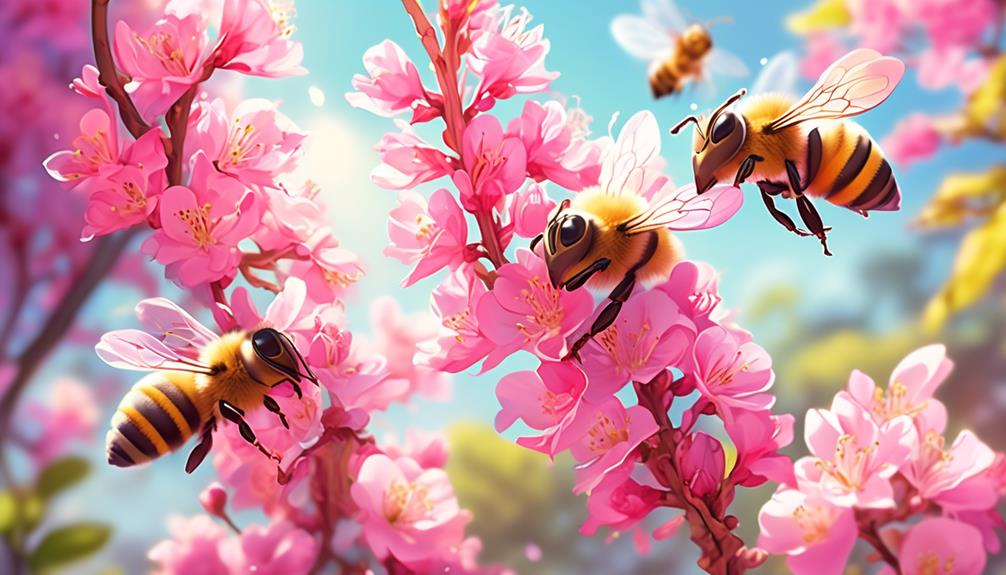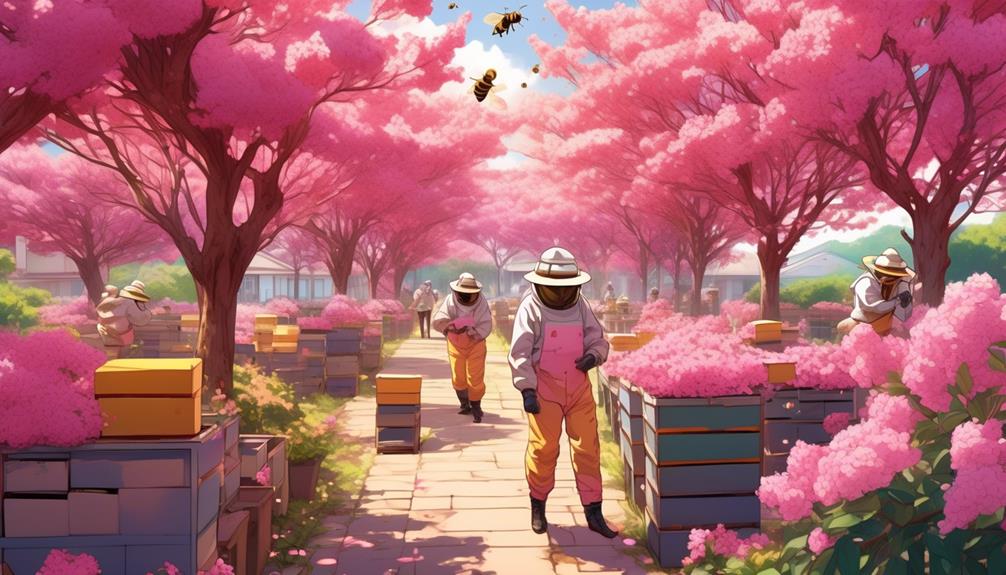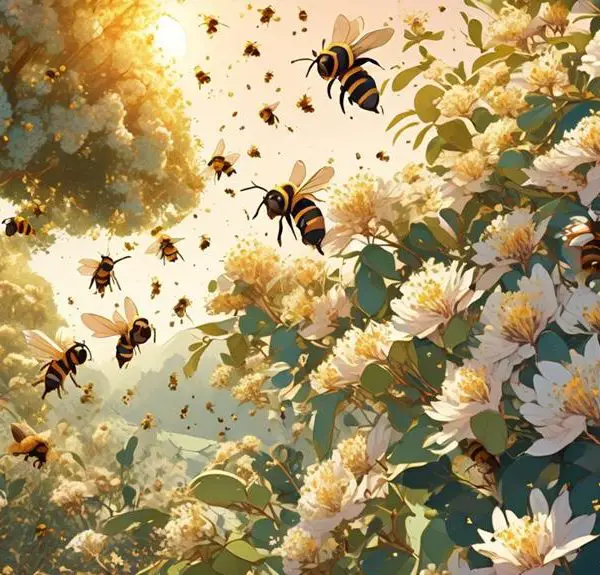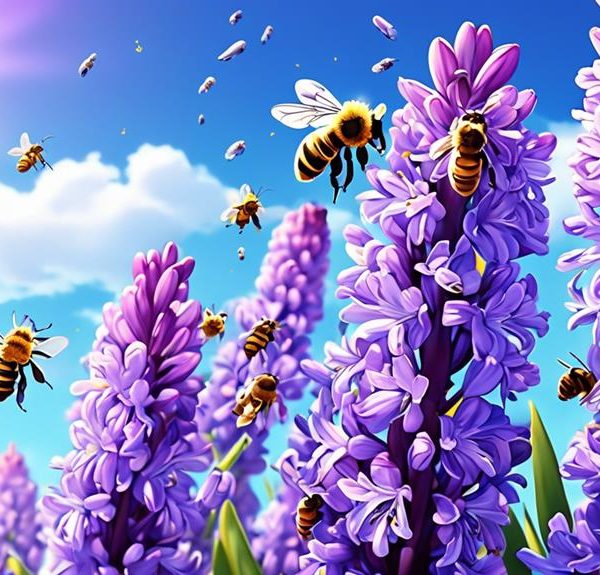Curious about the bond between honey bees and crepe myrtles? Discover the fascinating relationship that might revolutionize your garden perspective.

Do Honey Bees Like Crepe Myrtles?
Did you know that nearly one-third of the food we consume each day relies directly or indirectly on pollination by honey bees?
Now, consider the crepe myrtle, a flowering plant cherished for its vibrant summer blooms and attractive bark.
The question that naturally arises is, do honey bees, these crucial pollinators, have a penchant for crepe myrtles?
As you explore the connection between these industrious insects and this popular garden fixture, you'll uncover intriguing facts that may surprise you and possibly change the way you look at your own garden.
Key Takeaways
- Honey bees are attracted to Crepe Myrtles due to their vibrant blossoms and plentiful nectar.
- Crepe Myrtles provide a high nectar content, which serves as an energy source for honey bees.
- Honey bees inadvertently transfer pollen as they move from flower to flower, facilitating cross-pollination.
- Planting Crepe Myrtles can contribute to the survival and health of local honey bee populations and promote healthier and more robust growth of the trees.
Understanding Honey Bee Preferences

To truly grasp why honey bees are drawn to Crepe Myrtles, it's essential to delve into their unique preferences and understand the factors influencing their attraction to certain plants.
Bees, particularly honey bees, aren't random in their choices. They're methodical, driven by specific conditions that improve their survival and productivity.
One of these conditions is the abundance of nectar and pollen, which are primary food sources for bees. Plants that offer these in large amounts automatically attract bees. The Crepe Myrtle is one such plant, with its rich nectar stores and abundant pollen.
Another factor is the color of the flowers. Honey bees, it turns out, see colors differently than you do. They're more attracted to blue, purple, and yellow flowers. Crepe Myrtles, with their stunning array of bright blooms, fit this preference perfectly.
Lastly, there's fragrance. Honey bees have a strong sense of smell, using it to locate flowers brimming with nectar. Crepe Myrtles produce an enticing scent, further luring bees.
Crepe Myrtles: A Brief Overview

Diving into the world of Crepe Myrtles, you'll discover these are deciduous trees native to Eastern Asia, known for their vibrant summer blooms and smooth, peeling bark. Varied in size, they can grow as small shrubs or large trees reaching up to 30 feet. They're hardy plants, tolerating a range of soil types and light conditions. They're resilient too, often being the first to regrow in areas devastated by fire.
The Crepe Myrtles also offer a valuable nectar source for pollinators like bees during summer when food can be scarce. Here's a quick snapshot of the Crepe Myrtle's characteristics:
Feature | Description |
|---|---|
Family | Lythraceae |
Genus | Lagerstroemia |
Flowering period | June – September |
Height | 15 – 30 feet |
USDA Hardiness zones | 7 – 9 |
The Attraction Between Bees and Flowers

Building on the role of Crepe Myrtles as a nectar source, let's explore the fascinating interaction between bees and flowers, a dance of pollination that underpins much of our planet's biodiversity.
The relationship between bees and flowers is a perfect example of mutualism, where both parties benefit. Bees are attracted to flowers due to their bright colors and sweet nectar. They're equipped with an organ, the proboscis, that's perfectly designed to extract this nectar. As they move from flower to flower, pollen sticks to their bodies.
When they visit the next flower, some of this pollen rubs off, fertilizing the flower. This process, known as cross-pollination, is vital for plant reproduction. Flowers, on the other hand, have adapted to become attractive to bees. They've evolved bright colors, sweet scents, and nectar rewards to lure bees in.
In the case of Crepe Myrtles, their vibrant blossoms and abundant nectar make them particularly alluring to bees. Thus, the dance continues, a symbiotic relationship that's lasted millions of years and is essential for maintaining our planet's diverse ecosystems.
Crepe Myrtles and Honey Bees Connection

In the heart of summer, when the Crepe Myrtles are in full bloom, you'll often find honey bees buzzing around, drawn in by the tree's vibrant blossoms and plentiful nectar. This connection between Crepe Myrtles and honey bees isn't accidental but a well-crafted symbiosis in nature. Crepe Myrtles, with their extended blooming period, offer a consistent source of nectar and pollen for the bees.
You see, honey bees are primarily attracted to flowers with high nectar content. Crepe Myrtles fit this bill perfectly. Their sweet nectar serves as an energy source for the bees, while the pollen is a protein source, crucial for their larvae's growth. In return for this feast, the bees play a vital role in the tree's reproduction process. As they move from flower to flower, they inadvertently transfer pollen, facilitating cross-pollination.
This wonderful exchange underlines the importance of maintaining biodiversity in our gardens. Planting Crepe Myrtles not only beautifies your landscape but also contributes to the survival and health of local honey bee populations. So, next time you witness this interaction, remember, it's more than just bees enjoying a sweet treat; it's a critical ecological process in action.
Implications for Gardeners and Beekeepers

As a gardener or beekeeper, understanding the symbiotic relationship between Crepe Myrtles and honey bees can greatly influence your approach to landscape planning or beekeeping practices. Crepe Myrtles, with their nectar-rich blooms, attract honey bees and provide an abundant food source. On the other hand, honey bees assist in pollination, promoting a healthier and more robust growth of these trees.
Crepe Myrtles | Honey Bees | Implications |
|---|---|---|
Nectar-rich blooms | Attracted to Crepe Myrtles for food | Plant more Crepe Myrtles, increase bee population |
Require pollination | Bees assist in pollination | Healthier, robust growth of trees |
Bloom in summer | Active in summer | Synchronicity enhances mutual benefits |
For beekeepers, incorporating Crepe Myrtles near your hives can boost honey production. Gardeners, on the other hand, can benefit from the pollination services provided by the bees, resulting in healthier trees. Knowing this, you can adjust your landscaping or beekeeping strategies accordingly. Remember, it's not just about creating a beautiful garden or producing more honey, it's also about promoting a thriving ecosystem where both the bees and the trees mutually benefit.
Frequently Asked Questions
What Other Types of Flowers Do Honey Bees Commonly Prefer Apart From Crepe Myrtles?
You're curious about what flowers honey bees prefer besides crepe myrtles. Well, they're attracted to a variety of blooms. They love sunflowers, lavender, and borage, which are rich in nectar. Coneflowers, poppies, and daisies are also favorites.
Bees are particularly drawn to blue, purple, and yellow flowers. So, if you're looking to attract these pollinators, consider filling your garden with these colors and species.
How Do Changes in the Environment or Season Affect Honey Bee's Attraction to Crepe Myrtles?
Changes in environment or season can greatly affect a honey bee's attraction to crepe myrtles.
If it's colder, bees may not be able to forage as much. Likewise, if it's too hot or dry, crepe myrtles may not produce as much nectar.
In addition, changes in rainfall can impact nectar production.
Are There Any Negative Effects on Honey Bees When They Frequently Visit Crepe Myrtles?
There aren't any known negative effects on honey bees from frequenting crepe myrtles. On the contrary, they're attracted to these plants for their rich nectar and pollen. It's a mutually beneficial relationship.
The bees get a food source, and the crepe myrtles get pollinated. However, if the trees are treated with pesticides, that could pose a risk to the bees. You should always use bee-friendly products in your garden.
How Do Crepe Myrtles Influence the Taste or Quality of the Honey Produced by Bees?
Yes, crepe myrtles do influence the taste and quality of honey. When bees gather nectar from these plants, they essentially flavor the honey they produce. Crepe myrtle honey often has a unique, floral taste.
Furthermore, the quality of the honey increases due to the high nectar content in crepe myrtles. So, you're not only getting delicious honey but also a high-quality product when bees feed on crepe myrtles.
Are There Specific Species of Honey Bees That Are More Attracted to Crepe Myrtles?
Yes, there are indeed specific species of honey bees that show a preference for Crepe Myrtles. For instance, the European Honey Bee is particularly attracted to them. These bees are drawn to the Crepe Myrtle's vibrant flowers and the rich nectar they produce.
However, the level of attraction can vary based on the bee's individual preferences and the availability of other food sources. It's fascinating how nature works, isn't it?
Conclusion
So, do honey bees like crepe myrtles? You bet they do! These resilient trees offer nectar-rich blossoms, a true feast for the bees. They're not just attractive; they're also a valuable food source.
As a gardener or beekeeper, planting crepe myrtles can help support local honey bee populations. Remember, a thriving bee population means a healthier environment.
So go ahead, let your garden buzz with the sound of happy, crepe myrtle-loving bees.



